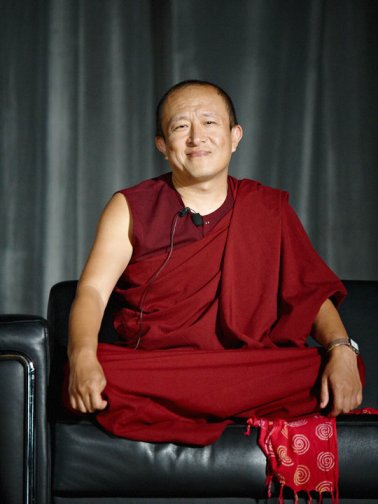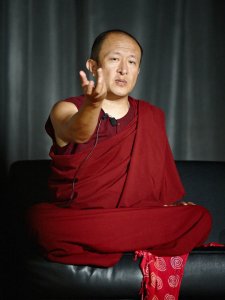This teaching was originally published in Shambhala Sun Magazine in 2003.
Just suppose that we have been born in a cinema hall. We don’t know that what is going on in front of us is just a projection. We don’t know that it is just a film, just a movie, and that the events in the movie aren’t real, that they have no true existence. Everything we see on that screen—love, hate, violence, suspense, thrills—is in fact just the effect of light projected through celluloid. But no one has ever told us this, so we just sit there watching, fixated on the film. If somebody tries to attract our attention, we say, “Shut up!” Even if we have something important to do, we don’t want to do it. We are completely engrossed and blind to the fact that this projection is completely futile.
Now suppose that there is someone in the seat next to us who says: “Look, this is just a film. It’s not real. This is not really happening. It’s really just a projection.” There’s a chance we too might understand that what we are seeing is in fact a movie, that it is unreal and essenceless.
This doesn’t automatically mean we get up and leave the cinema. We don’t have to do that. We can just relax and simply watch the love affair, the crime thriller or whatever. We can experience its intensity. And if we have a certain confidence that this is just a projection, then we can rewind, fast forward or play the film again as we like. And we have the choice to leave whenever we like, and to come back at another time to watch again. Once we are certain that we can leave any time we like, we may not feel compelled to do so. We can choose to sit comfortably and watch.
Sometimes a sequence in the movie can overwhelm our emotions. A tragic moment might hit our soft spot and we are carried away. But now, something in our heart is telling us that we know it’s not real, that it’s not a big deal.
This is what the dharma practitioner needs to understand—that the whole of samsara, or nirvana, is as essenceless or untrue as that film. Until we see this, it will be very difficult for dharma to sink into our minds. We will always be carried away, seduced by the glory and beauty of this world, by all the apparent success and failure. However, once we see, even just for a second, that these appearances are not real, we will gain a certain confidence. This doesn’t mean that we have to rush off to Nepal or India and become a monk or nun. We can still keep our jobs, wear a suit and tie and go with our briefcase to the office every day. We can still fall in love, offer our loved one flowers, exchange rings. But somewhere inside there is something telling us that all this is essenceless.
It is very important to have such a glimpse. If we have even one glimpse in the whole of our life, we can be happy for the rest of the time with just the memory of that glimpse.
Now, it could happen that when someone whispers to us, “Hey! This is just a film,” we don’t hear them because we are distracted. Perhaps just at that moment there is a big car crash in the movie, or loud music, so we just don’t hear the message. Or else maybe we do hear the message, but our ego misinterprets this information, so we remain confused and believe that there is something true and real in the movie after all. Why does that happen? It happens because we lack merit. Merit is incredibly important. Of course, intelligence, or prajna, is important. Compassion, or karuna, is important. But merit is paramount. Without merit, we are like an ignorant, illiterate beggar who wins a multi-million-dollar lottery but does not know what to do with the money and loses it straight away.
But suppose we do have a little merit and we actually get the message from the person whispering to us. Then, as Buddhists, we have different options. From the point of view of Theravada Buddhism, we get up and leave the movie hall, or we close our eyes, so we are not carried away by the movie. We put an end to suffering in that way. On the Mahayana level, we reduce our suffering through understanding that the movie is unreal, that it is all a projection and empty. We don’t stop watching the movie, but we see that it has no inherent existence. Moreover, we are concerned about the others in the cinema. Finally, in the Vajrayana, we know that it is just a movie, we are not fooled, and we just enjoy the show. The more emotion the movie evokes in us, the more we appreciate the brilliance of the production. We share our insights with our fellow viewers, who, we trust, are also able to appreciate what we see.
But to implement this in real life, we need merit. In Theravada Buddhism one accumulates merit through renunciation. We see that the movie is making us suffer and we have the sense to stop watching it. In the Mahayana we accumulate merit with compassion. We have a big and open mind that is more concerned with others’ suffering.
On the other hand, this transformation—from being caught up in the movie, to seeing the emptiness of the events in the film, to caring solely for the welfare of others—might take a very, very long time. This is why in the Vajrayana we move into the fast lane and accumulate merit through devotion. We trust the person who is whispering to us, and who has an understanding that has set him free. Not only do we assimilate the information he is giving us, but we also appreciate his freedom of mind and the depth of his being. We know we have the potential for such liberation too, and this makes us appreciate him even more. A single moment of such devotion, just a split second, just a little bit of such devotion, has immense merit. If we are in tune with the person whispering to us, he might help us discover the true inner movie-lover. He might make us see how the rest of the audience is caught up, and how unnecessary it all is. So without our having to rely on our own confused struggle to understand the path, this person brings us to an understanding of what it is we are seeing. We then become someone who can sit back and enjoy the show. And maybe we might whisper to some others as well.
From “Life as Cinema,” by Dzongsar Khyentse Rinpoche. Shambhala Sun, November 2003.
More details about Dzongsar Khyentse Rinpoche can be found on the Siddharta’s Intent website.




No comments:
Post a Comment